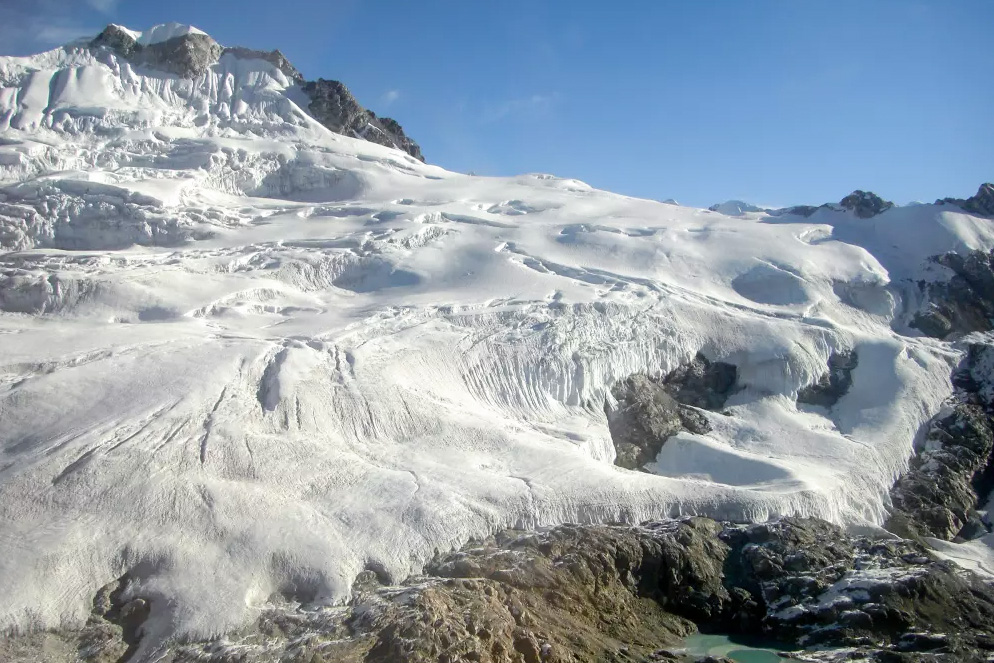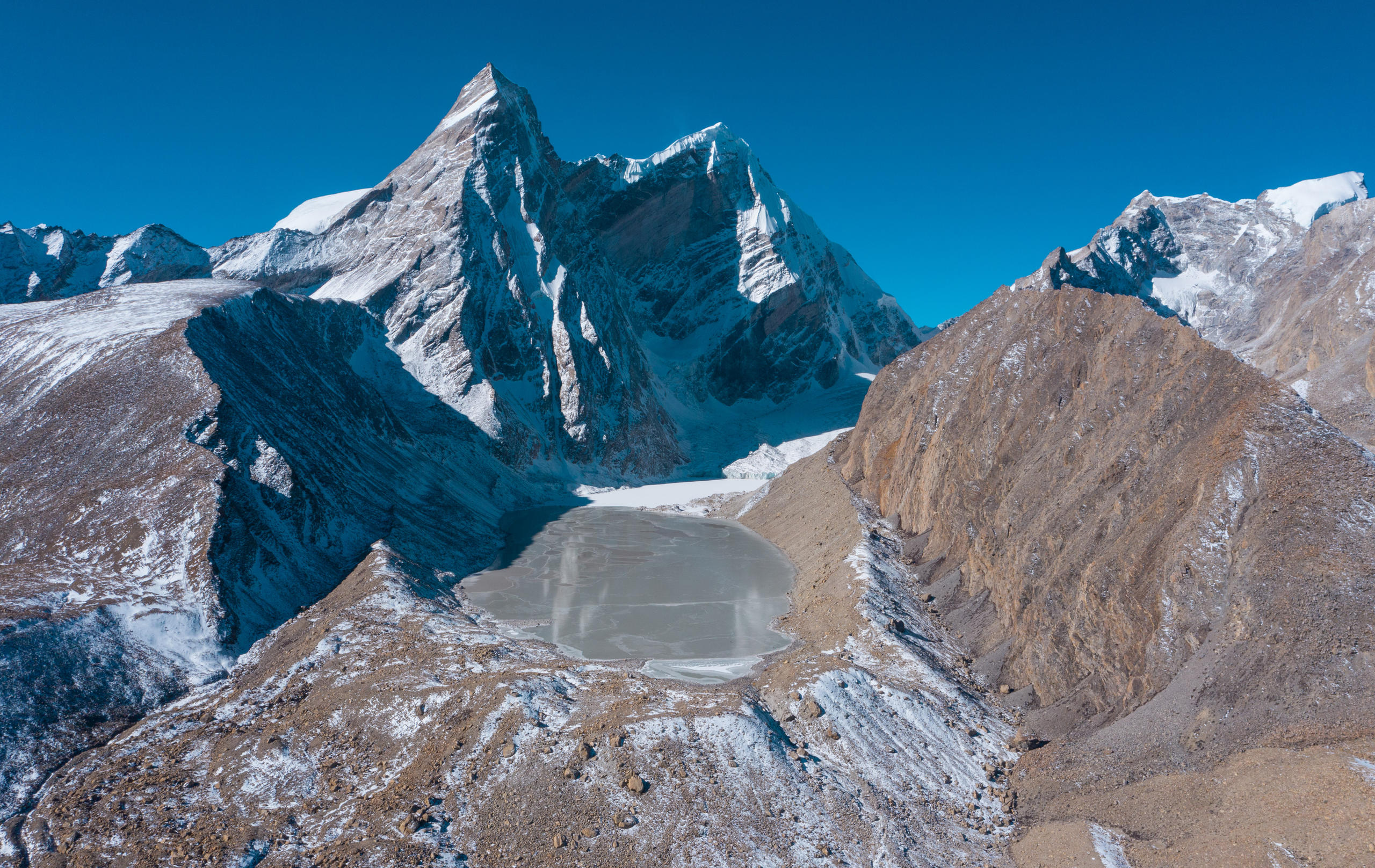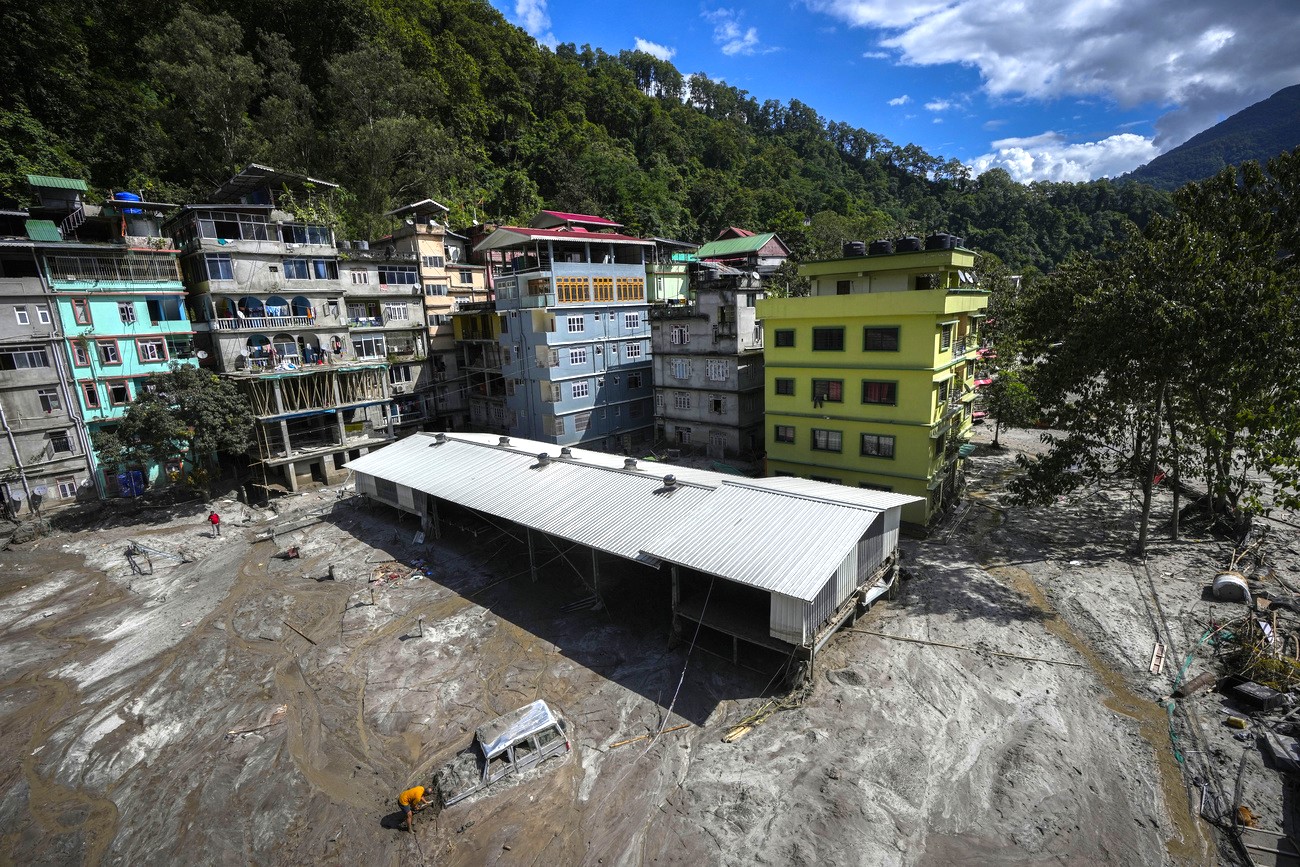
Nepal and the Himalayas, the agony of glaciers on the roof of the world

Melting Himalayan glaciers increase the risk of catastrophic flooding and reduce freshwater resources for nearly two billion people. The challenges for climate adaptation in a poor country like Nepal are immense.
At 8,848 metres, Mount Everest is the highest peak on the planet. But its altitude does not shelter the mountain from the effects of the warming climate. The thickness of the South Col glacier, Everest’s highest, has shrunk by more than 54 metresExternal link since the late 1990s.
“Recent studies show that Himalayan glaciers are melting at an accelerated pace,” says Sharad Joshi, a cryosphere expert at the International Center for Integrated Mountain Development (ICIMOD).
The Nepal-based organisation works for the sustainable development of the Hindu Kush Himalaya Mountain regions. Joshi is also the national correspondent in Nepal for the World Glacier Monitoring Service (WGMSExternal link), based in Switzerland.
The World Glacier Monitoring Service (WGMSExternal link) collects and analyses data on the mass balance, volume, area and length of the world’s glaciers. It was established in 1986 and is based at the University of Zurich, Switzerland. The WGMS has a network of national correspondents in more than 40 countries.
During the International Year for the Conservation of Glaciers, we contacted some of them to find out about the state of glaciers in their region, the consequences of ice melt and adaptation strategies.
The end of one of the most studied glaciers in Nepal
The melting of glaciers in the Hindu Kush HimalayaExternal link (HKH), a region spanning eight countries, is caused by rising global temperatures and local weather conditions (dry and cold with strong winds). Precipitation patterns are changing, and even at higher altitudes, there is more rainfall and less snowfall.

Between 2011 and 2020, the HKH’s approximately 56,000 glaciers melted 65% faster than in the previous decade, according to an ICIMOD studyExternal link. They could lose up to 80% of their volume by the end of the century.
Yala Glacier in Nepal’s Langtang Valley is among the most-studied glaciers in the country. It is also one of the glaciers monitored by the ICIMOD and submitted data to the WGMS and the only one in the Himalayan region to be included on the Global Glacier Casualty ListExternal link, a kind of world atlas of recently disappeared or critically endangered glaciers.
Its area shrank by more than a third between 1974 and 2021External link, and the glacier may disappear in the next 20 to 25 years. “Every time I visit the glacier I feel deep sadness to see its massive loss,” Joshi tells SWI swissinfo.ch.
The danger of collapsing proglacial lakes
Melting glaciers in Nepal, Joshi explains, create a cascade of effects that have consequences for communities and ecosystems both locally and globally.
Retreating glaciers lead to the formation of proglacial lakes. These are basins bounded by natural dams made up of ice or debris, called moraine. A landslide or earthquake could cause the sudden failure of these dams, leading to flooding (Glacial Lake Outburst Floods or GLOFs) and to devastating effects on villages, roads, bridges, hydropower plants and other infrastructure.
>> Watch the animation below to learn how a GLOF flood occurs:
In October 2023, a landslide that collapsed into South Lhonak Lake in the Himalayan region of India triggered a tsunami-like impact wave up to 20 metres high. The flood caused extensive damage along a 386-kilometre valley. At least 55 people were killed and 70 others were reported missing.
“This event impressively demonstrates how vulnerable high mountain regions are to the effects of climate change,” says Christian Huggel, professor of environment and climate at the University of Zurich and co-author of a recent studyExternal link on the South Lhonak disaster.
The number of proglacial lakes in the Himalayas is rapidly growingExternal link, according to ICIMOD. In Nepal, 21 lakes are considered at risk of flooding.
>> Vulnerable Himalayan border regions are facing an increasing risk of glacial lake outburst flooding. The Swiss approach is part of their strategy to deal with an uncertain future, as this article explains:

More
Himalayan nations can no longer ignore an environmental time bomb
Less water for two billion people
The consequences of melting glaciers are equally severe on a regional and global scale. Nepalese and Himalayan glaciers feed some of the world’s most important river basins, including those of the Ganges and Yellow River. Nearly two billion peopleExternal link depend on water from glaciers and snow in the Himalayas.
Glacier retreat reduces the flow of water downstream, causing seasonal water shortages that hurt agriculture and limit the availability of drinking water, Joshi explains. “The diminishing water supplies not only jeopardise farming and hydropower production, but also alter local ecosystems, endangering species adapted to cold environments.”
Melting Himalayan glaciers also contribute to sea level rise,External link with repercussions in coastal cities around the world.

Warning systems and lake drainage channels
In Nepal, some progress has been made in glacier conservation, adaptation to changes in water resources, and prevention of associated hazards, Joshi says. “However, there are significant challenges related to scale, funding, and technology”.
Early warning systems are in place in some vulnerable areas. Sensors and sirens warn downstream communities in case of GLOF flooding. In the Imja Tsho proglacial lake in the Everest area, an artificial drainage channel allows water levels to be lowered and reduces the risk of flooding.
However, many critical lakes are in remote and inaccessible areas. The cost of risk reduction is high for a country like Nepal, notes Joshi. The government estimates at US$47 billionExternal link (CHF41.4 billion) the investment needed until 2050 to adapt to climate change.
Effective glacier preservation and adaptation to the changing climate require stronger government policies, increased funding and enhanced regional cooperation, according to Joshi. “It is hoped that the International Year of Glacier Preservation will contribute positively to these efforts,” he says.
Edited by Gabe Bullard/ds

In compliance with the JTI standards
More: SWI swissinfo.ch certified by the Journalism Trust Initiative
















![The four-metre-long painting "Sonntag der Bergbauern" [Sunday of the Mountain Farmers, 1923-24/26] had to be removed by a crane from the German Chancellery in Berlin for the exhibition in Bern.](https://www.swissinfo.ch/content/wp-content/uploads/sites/13/2025/12/01_Pressebild_KirchnerxKirchner.jpg?ver=cb688ed5)















You can find an overview of ongoing debates with our journalists here . Please join us!
If you want to start a conversation about a topic raised in this article or want to report factual errors, email us at english@swissinfo.ch.